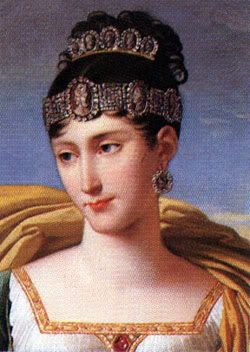Archduchess Yaroslava of Taraskovya
| Archduchess Yaroslava of Taraskovya | ||||||||
|---|---|---|---|---|---|---|---|---|

| ||||||||
|
Yaroslava was born to the family of a brother of the Taraskovyan Grand Duke, during a spring that was particularly generous to the country, which explains why her name in Slavonic signifies Spring’s Glory. Yet, it was also a time of religious instability throughout the Grand Duchy, times during which the Church of the Seven Deities decided to challenge the Treaty of Uiliath and regain influence over Tarasovka, a move that sparked a negative reaction from the Vigvar Patriarchate. The tensions increased between the mainly Taraskath followers of the Seven Deities, led by the powerful Tal-Nash family, and the mainly Russian Orthodox faithful, led by the Orlov family.
The Shakhovskoy family was taken in between, with the members of the family representing not only a mix of the Taraskath and Russian kins, but also a mixture of the two religious movements. Yaroslava was born to the Orthodox branch of the family and grew up as quite a religious person. The strength of her faith, however, did not prevent her from studying sciences and theories openly scuffed upon by the Vigvar Patriarchate. Bathed in an atmosphere of tension and plotting, the young woman became quite cunning and even manipulative, which made her the perfect candidate for a political maneuver undertaken by the Grand Duke.
And that is how, at the age of sixteen, she was married off to the nine-year old Knootian Prince Jan II of Knootcap. In those days, the House of Knootcap was considered as one of the Houses of lesser stature, no longer in command of a nation as it had once been. The young couple lived in an extended mansion in the cold and rainy province of Friesland, under one roof with the bitter and cruel widow of Johan of Knootcap, Anna. For Yaroslava, this was no doubt nothing less then exile.
Yaroslava did not much like her new husband, an immature child, more concerned with boys mischief than his wife. Surrounded by people that did not speak her own language, she isolated herself. When the first winter fell she picked up her old hobby, skating. She could skate for hours on end on the endless maze of frozen ditches and rivers and canals in the flat Frisian landscape. Locals nicknamed her the Ice Princess, as she would skate past everything and everyone without taking notice.
The tide turned for Yaroslava in 1747 when the Staten-Generaal made her husband Stadhouder in an attempt to unify the factions. Jan II was initially a popular ruler, speaking out against corruption and greed. However, as he grew up he took much after his father and spent most of his time enriching himself. She bore him two sons after which, it was rumoured, Jan was never again allowed into her bedroom.
It is rumoured that, hidden in shadows, she exercised some influence over her husband as well as the general course of Knootian politics. Quite unbecoming for a ‘proper’ woman, she took an interest in the affairs of state and managed to convince her husband time and again to take the course of action she desired. Members of the Staten-Generaal, at first reluctant to deal with, quickly accommodated to the situation. The Ice Princess of Friesland became the proverbial spider in the web of Knootian politics. With the experiences of the Grand Duchy, she played the different factions out against one another, blending her opinions to whichever guests she received on Noordeinde Palace. At her instigation, several expeditions were sent out to establish trading outposts in Haven, but these did not turn out to be as profitable as she had hoped.
Unfortunately for Yaroslava, the popularity of her husband waned as the excesses of his exploits at the Knootian East India Company came to light. Even some senators and representatives that had once professed to be close friends of Yaroslava were arguing once again for Republic as factional strife erupted in full force. Yaroslava was, however, still a woman to be reckoned with and when her husband died of Typhoid fever in 1760 she served as the regent for her 17-year-old son and, consequently, as leader of the United Provinces of Knootoss.
As regent, she attempted – unsuccesfully – to fight the corruption and factionalism that had crippled her new homeland. She had to watch with disgust as her eldest son, Jan III, became a virtual mirror of his father. Although he was initially well-intentioned like his father, her son turned out to be an even weaker ruler and powerless to halt the further degeneration of the country.
Yaroslava only saw the first signs of the impending doom, as the East India Company nearly went bankrupt in ’75, as the family lost much of its fortunes on a series of repeat expeditions to Haven that turned out to disastrous failures. The Ice Princess died in the summer palace, Huis den Bosch Palace, of natural causes before her son would finally be deposed.
